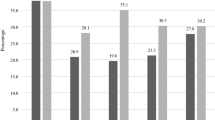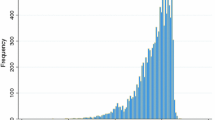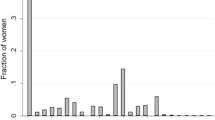Abstract
This paper examines fertility behavior of women in Kinshasa, Zaire's capital city with a population of roughly four million. We look at relationships linking women's education, employment, and fertility behavior (children ever born, age at first marriage, contraception, abortion, breastfeeding, and postpartum abstinence), using data from a 1990 survey of reproductive-age women. Other things equal, there are significant differences by educational attainment and by modern sector employment in lifetime fertility and in most of the proximate determinants as well. The results suggest that modern contraception and abortion are alternative fertility control strategies in Kinshasa, with abortion appearing to play an important role in contributing to the observed fertility differentials by education and employment. The dramatic increases that have taken place in women's access to secondary and higher education are likely to reduce fertility in the future, while the effects of Zaire's current economic and political crisis are uncertain. Our findings are consistent with some of the arguments of Caldwell et al. (1992) on a new type of fertility transition in sub-Saharan Africa. If Zaire seeks to lower fertility, policy efforts should be made to soften the impact of economic crisis on school enrollments and enhance opportunities for young women to remain in school, at least well into the secondary level. Policy should also seek to promote more effective ‘marketing’ and delivery of modern family planning services, so as to induce women to substitute modern contraception for abortion as a means of controlling their fertility.
Similar content being viewed by others
References
Allison, P.D. (1984). Event history analysis: Regression for longitudinal event data. Beverly Hills, CA: Sage Publications.
Ainsworth, M., Beegle, K. & Nyamete, A. (1995). The impact of female schooling on fertility and contraceptive use: A study of fourteen sub-Saharan countries. Living Standards Measurement Study Working Paper No. 110. Washington, DC: The World Bank.
Bakutuvwidi, M., Kinavwidi, N. & Way, A. (1985). Planification familiale, fecondué et santé familiale au Zaïre 1982-1984. Kinshasa: Institut National de la Statistique.
Becker, G.S. (1991). A treatise on the family, enlarged edition. Cambridge, MA: Harvard University Press.
Caldwell, J.C., Orubuloye, I.O. & Caldwell, P. (1992). Fertility decline in Africa: A new type of transition?, Population and Development Review 18: 211-242.
Cochrane, S.H. (1979). Fertility and education: What do we really know? Baltimore: Johns Hopkins I Tnivnrsity Press.
Dackam, N.R. (1990). L'Education de la mère et la mortalité des enfants en Afrique, Les Cahiers de l'IFORD No. 2. Yaoundé, Cameroon: Institut de Formation et de Recherche Démographiques (IFORD).
Easterlin, R. A. & Crimmins, E. M. (1985). The fertility revolution: A supply-demand analysis. Chicago: University of Chicago Press.
Foster, A. (1993). The effects of economic fluctuations on marriage and fertility in sub-Saharan Africa. Paper presented at the 1993 Annual Meeting of the Population Association of America, Cincinnati, Ohio, USA.
Janowitz, B. & Smith, J. (1984). Pregnancy intervals, breastfeeding and contraception, pp. 40-47, in: B. Janowitz, J. Lewis, N. Burton, & P. Lamptey (eds.) Reproductive health in Africa: Issues and options. Research Trianglc Park: Family Health International.
Lesthaeghe, R.J. (1989). Introduction and Production and reproduction in sub-Saharan Africa: An overview of organizing principles, pp. 1-59, in: R. J. Lesthaeghe (ed.), Reproduction and social organization in sub-Saharan Africa. Berkeley: University of California Press.
Lesthaeghe, R.J. (1993). Are there crisis-led fertility transitions? Paper presented at the 1993 Annual Meeting of the Population Association of America, Cincinnati, Ohio, USA.
Lloyd, C.B. (1991). The contribution of the world fertility surveys to an understanding of the relationship between women's work and fertility, Studies in Family Planning 22: 144-161.
Mason, K.O. (1984). The status of women: A review of its relationships to fertility and mortality. Ann Arbor: Population Studies Center, University of Michigan.
Muhuri, P.K., Blanc, A.K. & Rutstein, S.O. (1994). Socioeconomic differentials in fertility. Demographic and Health Surveys Comparative Studies No. 13. Calverton, MD: Macro International Inc.
National Academy of Sciences (1993). Demographic effects of economic reversals. Washington, DC: National Academy Press.
Ngondo, a.P.I. (1980). De la nuptialité et de la fécondité des polygames: Le cas des Yaka de Popokabaka. Tervuren (Belgium): Musée Royal d'Afrique Centrale.
Oni, G.A. (1985). The effects of women's education on postpartum nonsusceptible period in Ilarin, an urban community in Nigeria. Ann Arbor: University Microfilms International.
Palloni, A., Hill, K. & Aguirre, G.P. (1993). Economic swings and demographic changes in the history of Latin America. Paper presented at the 1993 Annual Meeting of the Population Association of America. Cincinnati, Ohio, USA.
Piripiri, L. et al. (1989). Pratiques sexuelles et perception du risque d'attraper le SIDA chez les adolescents scolarisés de la ville de Kinshasa. Kinshasa: Ecole de Santé Publique, Université de Kinshasa.
Poirier, J., Piché, V., & Neill, G. (1989). Travail des femmes et fécondité dans les pays en développement: Que nous a appris l'enquête mondiale de la fécondité?, Cahiers Québécois de Démographie 18(1): 159-183.
Romaniuk, A. (1967). La fécondité des pupulations congoluises. Paris, France: Mouton.
Romaniuk, A. (1980). Increase in natural fertility during the early stages of modernization: evidence from an African case study, Zaire, Population Studies 34(2): 295-310.
Sala-Diakanda. M. (1980). Approche ethnique des phénomènes demographiques: Le cas du Zaïre. Louvain-la-Neuve (Belgium): Cabay Libraire-Editeur.
Shapiro, D. (1992). Labor markets in Kinshasa and Bandundu. Unpublished report prepared for Cornell University Food and Nutrition Policy Program. Pennsylvania State University, Department of Economics.
Shapiro, D. (1996). Fertility decline in Kinshasa. Population Studies 50(1): 89-103.
Shapiro, D. & Tambashe, B.O. (1994a). The impact of women's employment and education on contraceptive use and abortion in Kinshasa, Zaire, Studies in Family Planning 25: 96-110.
Shapiro, D. & Tambashe, B.O. (1994b). Poverty, women's schooling, and economic activity in Kinshasa. Paper presented at the 1994 Annual Meeting of the Population Association of America, Miami, Florida. USA.
Standing, G. (1983). Women's work activity and fertility, pp. 416-438, in: R.A. Bulatao et al. (eds.), Determinants of Fertility in Developing Countries: A Summary of Knowledge. Washington, DC: National Academy Press.
Tabutin, D. (1982). Evolution régionale de la fécondité dans l'ouest du Zaïre, Population 37: 29-50.
Tambashe, B.O. (1984). Niveau et corrélats de la fécondité des mariages â Kinshasa: Examen par les Variables lntermédiaires. Louvain-la-Neuve (Belgium): Cabay Libraire-Editeur.
Tambashe, B. O. & Shapiro, D. (1991). Employment, education, and fertility behavior: Evidence from Kinshasa. Kinshasa: Département de Démographie, Université de Kinshasa.
Tambashe, B.O, & Shapiro, D. (1996). Family background and early life course transitions in Kinshasa. Working Paper. Pennaylvania State University, Department of Economics.
United Nations (1986). Education and fertility: Selected findings from the world fertility survey data. New York: Population Division, United Nations.
Author information
Authors and Affiliations
Rights and permissions
About this article
Cite this article
Shapiro, D., Tambashe, B.O. Education, employment, and fertility in Kinshasa and prospects for changes in reproductive behavior. Population Research and Policy Review 16, 259–287 (1997). https://doi.org/10.1023/A:1005761504449
Issue Date:
DOI: https://doi.org/10.1023/A:1005761504449




